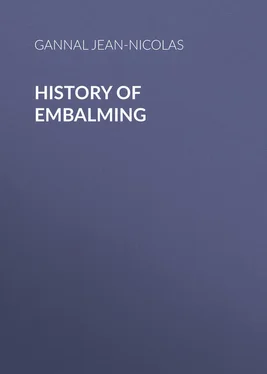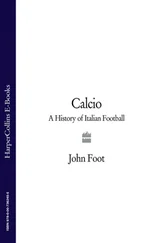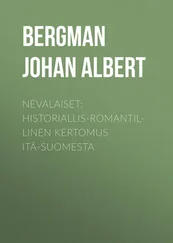Jean-Nicolas Gannal - History of Embalming
Здесь есть возможность читать онлайн «Jean-Nicolas Gannal - History of Embalming» — ознакомительный отрывок электронной книги совершенно бесплатно, а после прочтения отрывка купить полную версию. В некоторых случаях можно слушать аудио, скачать через торрент в формате fb2 и присутствует краткое содержание. Жанр: foreign_antique, foreign_prose, на английском языке. Описание произведения, (предисловие) а так же отзывы посетителей доступны на портале библиотеки ЛибКат.
- Название:History of Embalming
- Автор:
- Жанр:
- Год:неизвестен
- ISBN:нет данных
- Рейтинг книги:5 / 5. Голосов: 1
-
Избранное:Добавить в избранное
- Отзывы:
-
Ваша оценка:
- 100
- 1
- 2
- 3
- 4
- 5
History of Embalming: краткое содержание, описание и аннотация
Предлагаем к чтению аннотацию, описание, краткое содержание или предисловие (зависит от того, что написал сам автор книги «History of Embalming»). Если вы не нашли необходимую информацию о книге — напишите в комментариях, мы постараемся отыскать её.
History of Embalming — читать онлайн ознакомительный отрывок
Ниже представлен текст книги, разбитый по страницам. Система сохранения места последней прочитанной страницы, позволяет с удобством читать онлайн бесплатно книгу «History of Embalming», без необходимости каждый раз заново искать на чём Вы остановились. Поставьте закладку, и сможете в любой момент перейти на страницу, на которой закончили чтение.
Интервал:
Закладка:
The same phenomenon still occurs in different parts of our country, under a moderate temperature: thus, about 1660, M. de La Visèe and his domestic, having been assassinated at Paris, and interred on the place where the crime was committed, their bodies were discovered after the lapse of a year, whole and readily recognisable; a cloak even, lined with plush, had not suffered the least alteration.
The mummy of the avalanches, and all those, the preservation of which is due to a constant low temperature, retain the freshness and plumpness of the tissues for years and for centuries, if the conditions of the medium remain the same; but, under these circumstances, the action of cold exerts no other influence than the suspension of decomposition; for the moment it ceases, the tissues are rapidly exposed to the laws of inorganic chemistry.
In those cases, however, where the bodies exposed to cold are subjected to a dry and lively wind, a real mummification may occur, as in the following example:
There is upon the summit of the Great Saint Bernard, a sort of morgue ( dead house ) in which have been deposited, from time immemorial, the bodies of those unfortunate persons who have perished upon this mountain by cold, or the fall of avalanches.
The study of the circumstances of locality, and of temperature, in which this establishment is placed, may, to a certain degree, indicate the most favourable conditions for the long preservation of bodies. Here they show to travellers, bodies, which they assert have been sufficiently well preserved to be recognisable after the lapse of two or three years. A physician, whose quality as ancient prosector of the faculty of Medicine of Paris, rendered him curious to visit this part of the hospital in all its details, has verified with his own eyes all that travellers have written, and has transmitted to us the following observation:
The hospital of Saint Bernard, is, as is well known, the most elevated habitation in Europe, being 7,200 feet above the level of the sea. The temperature of this part of the globe is always very low, rarely above zero, even during summer. This extensive establishment is built upon the borders of a little lake, at the bottom of a little gorge; the principal mass of the building represents a long parallelogram placed in the direction of the gorge, so that its two principal faces, pierced with numerous windows, are sheltered from the wind by the rocks; whilst the two extremities, on the contrary, are exposed to all the violence of those which blow from one side of the gorge to the other. About fifty steps beyond this principal building, and a little out of a right line with it, is situated the morgue , a sort of square chamber, the walls of which, three or four feet thick, are constructed of good stone, and the arched roof of which is very solid. Two windows of about four feet square, are pierced in the direction of the breadth of the valley, directly facing each other, so that a perpetual current of cool air traverses the interior of the chamber. There is, further, but a single table in this morgue, upon which they place the bodies when first introduced; after a while they are arranged around the walls in an upright attitude. At the time of my passage of the Great Saint Bernard, (31st August , 1837,) there were several of these mummified bodies along the walls of the chamber, but a greater number were entirely divested of flesh, and lie scattered about the earthy floor of the room. They informed me, that decomposition only took place when the bodies fell by accident to the ground; which was owing to the humidity occasioned by the snow, which occasionally entered with the currents of air through the windows of the morgue. 11 11 Early in September, 1833, I had an opportunity of inspecting the contents of the morgue of Saint Bernard. Among the group of bodies of every age and sex, we were particularly struck with two figures, one, that of a man, whose countenance was horridly contorted by the act of desiccation; each limb, and every muscle of the body, had assumed the expression of a wretch in purgatory. The other was that of a mother holding her infant to her bosom, the latter, with an imploring expression, looking up to the face of the mother, whom it appeared to have survived some time, as is generally the case when mother and child are frozen together – a greater power of forming animal heat existing in children. — Tr.
(Note communicated by Dr. Lenoir.)
The existence of the mummies of the sands, is attested by numerous travellers, and all the authors who have written on embalming mention them. They are every where found, where an arid and burning atmosphere deeply penetrates the masses of fine sand, easily agitated by the winds. In Egypt, for example, Herodotus frequently speaks of these bodies dried by the sun. Cambyses, on the authority of this author, suffered horrible effects from these sands, driven before the wind; he lost almost his whole army during his expedition to the temple of Jupiter Ammon.
Pere Kircher gives us an interesting description of these sand storms: “In the countries of Africa situated beyond the Nile, is a vast desert of sand, the immense waves of which appear in the boundless horizon like those of the sea. Agitated by the winds, these sands produce such frightful tempests, that they swallow up under their enormous masses, travellers, beasts of burden, and merchandise. Bodies thus engulfed, become desiccated after a series of years, both by the ardour of the sun’s rays, and by virtue of the burning sand: this is the reason that some have asserted that mummies might be formed by natural causes only, &c.” 12 12 The following is the passage of P. Kircher, of which we gave only a few passages in our citation. “Est in Transpilana Africæ regione, desertum ingens sabuli, arenarumque cumulis in immensum exporrectum, unde et sabulosi maris non immerito nomen obtinuit; hæ siquidem arenæ ventis concitatæ tam sævas subinde tempestates movent, ut arenis in clivos aggestis, turbinum violentia, et jumenta et viatores una cum mercibus suis, nulla evadendi spe relicta, vivos sepiliant. Refert Pomponius Mela de rupe qua dam in hoc deserto existente, austro consecrata, quæ simul atque vel manu tacta fuerit, austro mox provocato, Sævissimas procellas moveat, sabulo in tantum intumescente, ut pelagus undarum vorticibus, fluctuumque æstibus concitatum videraqueat. Hanc rupem dum olim sylli inconsultius adeunt sive occultiori naturæ impetu, sive magicis incantationum præstigiis, vento mox exoriente, et sabulosos cogente montes, ad unum omnes extincti ferunter. Est et in hoc deserto, ammonium oraculum et serapium, sphyngesque ingentes quarum aleæ usque ad caput, aleæ ex dimidio arena obrutæ, strabone teste, spectantur. Hoc itaque celeberrimum oraculum consulturus olim Alexander Magnus, dum pleno aleæ itineri se accingit, ad illud quidem incolumis pervenit, sed quos milites ex suo exercita non sabulosi pelagi turbines, hos æstus, sitisque confecisse traditur. Sed ut unde digressus revertar, in hoc sabuloso deserto dicunt non nulli mumias solius naturæ industria confici; dum aiunt, viatorum deserti tempestatibus extinctorum corpora tum solis tunc ferventissimæ hugus arenæ pinguioris virtute, longo tempore siccata, tostaque, in hunc statum degenerare. Sed tametsi subinde, in hoc Lybiæ deserto hugusmodi a sole exsiccata corpora reperiantur, illa tamen minime mumiæ discendæ sunt.”
Penicher, Clauderus, De Maillet, Rouelle Le Comte de Caylus, cite examples of the same nature. A whole caravan, or some travellers, disappear under a mass of sand; years, centuries, pass by, then a new revolution in the disposition of these masses restores to the light of day, those bodies which a previous revolution had engulfed; blackened, dried, and lightened by the loss of all their fluids. In Mexico, Mr. Humboldt met with true mummies. Travellers have visited battlefields, situated on a soil deprived of rain, and in a burning atmosphere. They saw with astonishment, that these fields were covered with the dead bodies of Spaniards and Peruvians, dried and preserved for a long time. At the side of these phenomena which nature offers us, come the mummies of which Maillet speaks in his letters on Egypt.
Интервал:
Закладка:
Похожие книги на «History of Embalming»
Представляем Вашему вниманию похожие книги на «History of Embalming» списком для выбора. Мы отобрали схожую по названию и смыслу литературу в надежде предоставить читателям больше вариантов отыскать новые, интересные, ещё непрочитанные произведения.
Обсуждение, отзывы о книге «History of Embalming» и просто собственные мнения читателей. Оставьте ваши комментарии, напишите, что Вы думаете о произведении, его смысле или главных героях. Укажите что конкретно понравилось, а что нет, и почему Вы так считаете.












